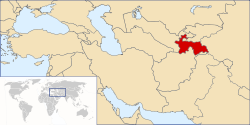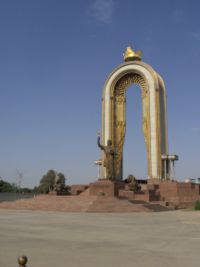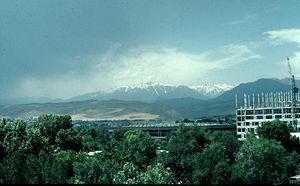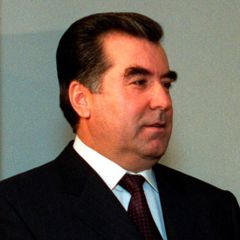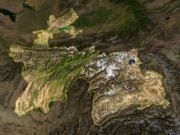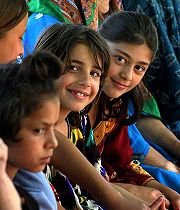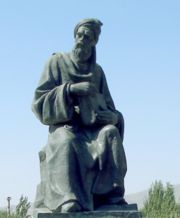Tajikistan
2008/9 Schools Wikipedia Selection. Related subjects: Asia; Asian Countries
| Ҷумҳурии Тоҷикистон Jumhurii Tojikiston Republic of Tajikistan
|
||||||
|---|---|---|---|---|---|---|
|
||||||
| Motto: none | ||||||
| Anthem: Surudi Milli |
||||||
|
|
||||||
| Capital (and largest city) |
Dushanbe |
|||||
| Official languages | Tajik | |||||
| Demonym | Tajik | |||||
| Government | Unitary presidential republic | |||||
| - | President | Emomalii Rahmon | ||||
| - | Prime Minister | Oqil Oqilov | ||||
| Independence | ||||||
| - | Establishment of the Samanid Empire | 875 AD | ||||
| - | Declared | September 9, 1991 | ||||
| - | Completed | December 25, 1991 | ||||
| Area | ||||||
| - | Total | 143,100 km² ( 95th) 55,251 sq mi |
||||
| - | Water (%) | 0.3 | ||||
| Population | ||||||
| - | January 2006 estimate | 6,920,3001 ( 100th1) | ||||
| - | 2000 census | 6,127,000 | ||||
| - | Density | 45/km² ( 151st) 117/sq mi |
||||
| GDP ( PPP) | 2005 estimate | |||||
| - | Total | $8.802 billion ( 139th) | ||||
| - | Per capita | $1,388 ( 159th) | ||||
| Gini (2003) | 32.6 (medium) | |||||
| HDI (2007) | ▲ 0.673 (medium) ( 122nd) | |||||
| Currency | Somoni ( TJS) |
|||||
| Time zone | TJT ( UTC+5) | |||||
| Internet TLD | .tj | |||||
| Calling code | +992 | |||||
| 1 | Estimate from State Statistical Committee of Tajikistan, 2006; rank based on UN figures for 2005. | |||||
Tajikistan (pronounced /təˈdʒɪkɨstæn/ or /təˈdʒiːkɨstæn/; Tajik: Тоҷикистон, pronounced [tɔʤikɪsˈtɔn] or [tɒːʤikɪsˈtɒn], Persian: تاجیکی, tojikí), officially the Republic of Tajikistan ( Tajik: Ҷумҳурии Тоҷикистон) is a mountainous landlocked country in Central Asia. Afghanistan borders to the south, Uzbekistan to the west, Kyrgyzstan to the north, and China to the east. Most of Tajikistan's population belongs to the Tajik ethnic group, who share culture and history with the Persian peoples and speak the Tajik language, a modern variety of Persian. Once part of the Samanid Empire, Tajikistan became a constituent republic of the Soviet Union in the 20th century, known as the Tajik Soviet Socialist Republic ( Tajik SSR).
After independence, Tajikistan suffered from a devastating civil war which lasted from 1992 to 1997. Since the end of the war, newly-established political stability and foreign aid have allowed the country's economy to grow. Its natural resources such as cotton and aluminium have contributed greatly to this steady improvement, although observers have characterized the country as having few natural resources besides hydroelectric power and its strategic location.
Etymology
Tajikistan means the "Land of the Tajiks" in Persian. Some believe the name Tajik is a geographic reference to the crown (Taj) of the Pamir Knot, but this is a folk etymology. The word "Tajik" was used to differentiate Iranians from Turks in Central Asia, starting as early as the 10th century. The addition of 'k' might have been for the purpose of euphony in the set phrase "Turk-o Tajik" ("Turks and Tajiks") which in Persian-language histories is found as an idiomatic expression meaning "everyone." According to some other sources, the name Tajik (also spelled Tadjik, Tadzhik) refers to a group of people who are believed to be one of the pure and close descendents of the ancient Aryans. Their country was called Aryana Vajeh and the name "Taa-jyaan" from which came the word Tajik is mentioned in The Avesta. The Zoroaster's Gathas were also directed to an Aryan audience and there are several references to this community as being situated in the "home" of the Aryans.
Tajikistan frequently appeared as Tadjikistan or Tadzhikistan in English. This former transliteration of Tadjikistan or Tadzhikistan is from the Russian Таджикистан. (In Russian there is no single letter j to represent the phoneme /ʤ/ and дж, or dzh, is used.) Tadzhikistan is the most common alternate spelling and is widely used in English literature derived from Russian sources. Tadjikistan is the spelling in French and can occasionally be found in English language texts. In the Perso-Arabic script, "Tajikistan" is written تاجیکستان.
Controversy surrounds the correct term used to identify people from Tajikistan. The word Tajik has been the traditional term used to describe people from Tajikistan and appears widely in literature. But the ethnic politics of Central Asia have made the word Tajik a controversial word, as it implies that Tajikistan is only a nation for ethnic Tajiks and not ethnic Uzbeks, Russians, etc. Likewise, ethnic Tajiks live in other countries, such as China, making the term ambiguous. In addition, the Pamiri population in Gorno-Badakhshan also have sought to create an ethnic identity separate from that of the Tajiks.
History
Early history
The territory of what is now Tajikistan has been inhabited continuously since 4000 BCE. It has been under the rule of various empires throughout history, for the longest period under the Persian Empire.
Most of modern Tajikistan had formed parts of ancient Kamboja and Parama Kamboja kingdoms, which find references in the ancient Indian epics like the Mahabharata. Linguistic evidence, combined with ancient literary and inscriptional evidence has led many eminent Indologists to conclude that ancient Kambojas (an Avestan speaking Iranian tribe) originally belonged to the Ghalcha-speaking area of Central Asia. Achariya Yasaka's Nirukta (7th century BCE) attests that verb Śavati in the sense "to go" was used by only the Kambojas. It has been shown that the modern Ghalcha dialects, Valkhi, Shigali, Sriqoli, Jebaka (also called Sanglichi or Ishkashim), Munjani, Yidga and Yagnobi, mainly spoken in Pamirs and countries on the headwaters of the Oxus, still use terms derived from ancient Kamboja Śavati in the sense "to go". The Yagnobi dialect spoken in Yagnobi province around the headwaters of Zeravshan valley in Sogdiana, also still contains a relic "Śu" from ancient Kamboja Śavati in the sense "to go". Further, Sir G Grierson says that the speech of Badakshan was a Ghalcha till about three centuries ago when it was supplanted by a form of Persian. Thus, the ancient Kamboja, probably included the Badakshan, Pamirs and northern territories including Yagnobi province in the doab of the Oxus and Jaxartes. On the east it was bounded roughly by Yarkand and/or Kashgar, on the west by Bahlika ( Uttaramadra), on the northwest by Sogdiana, on the north by Uttarakuru, on the southeast by Darada, and on the south by Gandhara. Numerous Indologists locate original Kamboja in Pamirs and Badakshan and the Parama Kamboja further north, in the Trans-Pamirian territories comprising Zeravshan valley, north up parts of Sogdhiana/Fargana — in the Sakadvipa or Scythia of the classical writers. Thus, in the pre-Buddhist times (7th–6th century BCE), the parts of modern Tajikistan including territories as far as Zeravshan valley in Sogdiana formed parts of ancient Kamboja and the Parama Kamboja kingdoms when it was ruled by Iranian Kambojas till it became part of Achaemenid Empire.
From the last quarter of fourth century BCE till the first quarter of the second century BCE, it was part of the Bactrian Empire, from whom it was passed on to Scythian Tukharas and hence became part of Tukharistan. Contact with the Chinese Han Dynasty was made in the second century BCE, when envoys were sent to the area of Bactria to explore regions west of China.
Arabs brought Islam in the 7th century CE. The Samanid Empire Persians supplanted the Arabs and built the cities of Samarkand and Bukhara, which became the cultural centers of Tajiks (both of which are now in Uzbekistan). The Mongols would later take partial control of Central Asia, and later the land that today comprises Tajikistan became a part of the emirate of Bukhara. A small community of Jews, displaced from the Middle East after the Babylonian captivity, migrated to the region and settled there after 600 BCE, though the majority of the recent Jewish population did not migrate to Tajikistan until the 20th century.
Russian presence
In the 19th century, the Russian Empire began to spread into Central Asia during the Great Game, and it took control of Tajikistan. After the overthrow of Imperial Russia in 1917, guerrillas throughout Central Asia, known as basmachi waged a war against Bolshevik armies in a futile attempt to maintain independence. The Bolsheviks prevailed after a four-year war, in which mosques and villages were burned down and the population heavily suppressed. Soviet authorities started a campaign of secularization, practicing Muslims, Jews, and Christians were persecuted, and mosques, churches, and synagogues were closed. The Jews of Tajikistan are known as Bukharian Jews. In the 1970s to 1990s there was a huge emigration of Bukharians to the United States of America. Today, there are flourishing Buharian communities in New York City, United States and in many other east coast cities of the U.S.
Soviet Tajikistan
In 1924, the Tajik Autonomous Soviet Socialist Republic was created as a part of Uzbekistan, but in 1929 the Tajik Soviet Socialist Republic ( Tajik SSR) was made a separate constituent republic. The predominantly ethnic Tajik cities of Samarkand and Bukhara remained in the Uzbek SSR. In terms of living conditions, education and industry Tajikistan was somewhat behind the other Soviet Republics. By the late 1980s Tajik nationalists were calling for increased rights. Real disturbances did not occur within the republic until 1990. The following year, the Soviet Union collapsed, and Tajikistan declared its independence.
Post-Independence
The nation almost immediately fell into a civil war that involved various factions fighting one another; these factions were often distinguished by clan loyalties. The non-Muslim population, particularly Russians and Jews, fled the country during this time because of persecution, increased poverty and better economic opportunities in the West or in other former Soviet republics. Emomali Rahmonov came to power in 1992, and continues to rule to this day. However, he has been accused of ethnic cleansing against other ethnicities and groups during the Civil war in Tajikistan. In 1997, a ceasefire was reached between Rahmonov and opposition parties ( United Tajik Opposition). Peaceful elections were held in 1999, but they were reported by the opposition as unfair, and Rahmonov was re-elected by almost unanimous vote. Russian troops were stationed in southern Tajikistan, in order to guard the border with Afghanistan, until summer 2005. Since the September 11, 2001, attacks, American, Indian and French troops have also been stationed in the country.
In 2008, the harshest winter in a quarter century caused financial losses of $850 million. Russia pledged $1 billion in aid. Saudi Arabia sent about 10 planes carrying 80 tons of relief and emergency supplies in February and another 11 tons in March.
Politics
Almost immediately after independence, Tajikistan was plunged into a civil war that saw various factions, allegedly backed by Russia and Iran, fighting one another. All but 25,000 of the more than 400,000 ethnic Russians, who were mostly employed in industry, fled to Russia. By 1997, the war had cooled down, and a central government began to take form, with peaceful elections in 1999.
"Longtime observers of Tajikistan often characterize the country as profoundly averse to risk and skeptical of promises of reform, a political passivity they trace to the country’s ruinous civil war," Ilan Greenberg wrote in a news article in The New York Times just before the country's November 2006 presidential election.
Tajikistan is officially a republic, and holds elections for the President and Parliament. The latest elections occurred in 2005, and as all previous elections, international observers believe them to have been corrupt, arousing many accusations from opposition parties that President Emomali Rahmon manipulates the election process.
The November 6, 2006, election was boycotted by "mainline" opposition parties, including the 23,000-member Islamist Islamic Renaissance Party. Four remaining opponents "all but endorsed the incumbent", Rahmon. After November 2006 presidential elections, it is widely speculated that Rahmon has secured his seat for at least another two terms, which will allow him rule till 2020.
Tajikistan to this date is one of the few countries in Central Asia to have included an active opposition in its government. In the Parliament, opposition groups have often clashed with the ruling party, but this has not led to great instability.
On October 11, 2007, the Assembly of the Council Commission of the Ministry of Culture issued a decision to ban Jehovah’s Witnesses in the Republic of Tajikistan. Following the fall of the Berlin Wall in 1989 and after the breakup of the Soviet Union, the activity of Jehovah’s Witnesses was legally recognized by many post-Soviet republics. Since that time, however, this is the first Soviet republic to ban the activity of Jehovah’s Witnesses.
Recently Tajikistan also gave Iran its support in the membership bid to join the SCO, after a meeting with Tajik President and Iranian foreign minister.
Administrative divisions
Tajikistan consists of 4 administrative divisions. These are the provinces ( viloyat) of Sughd and Khatlon, the autonomous province of Gorno-Badakhshan (abbreviated as GBAO), and the Region of Republican Subordination (RRP – Raiony Respublikanskogo Podchineniya in Russian; formerly known as Karotegin Province). Each region is divided into several districts ( Tajik: Ноҳия, nohiya or raion), which in turn are subdivided into jamoats (village-level self-governing units). As of 2006, there were 58 districts and 367 jamoats in Tajikistan.
| Division | ISO 3166-2 | Capital | Area (km²) | Pop (2006) |
|---|---|---|---|---|
| Sughd | TJ-SU | Khujand | 25,400 | 2,060,900 |
| Region of Republican Subordination | TJ-RR | Dushanbe | 28,600 | 1,531,300 |
| Khatlon | TJ-KT | Qurghonteppa | 24,800 | 2,463,300 |
| Gorno-Badakhshan | TJ-BG | Khorugh | 64,200 | 218,400 |
Source: Population and area from State Statistical Committee of Tajikistan
Geography
Tajikistan is landlocked, and is the smallest nation in Central Asia by area. It is covered by mountains of the Pamir range, and more than fifty percent of the country is over 3,000 meters (approx. 10,000 ft) above sea level. The only major areas of lower land are in the north which is part of the Fergana Valley, and in the southern Kafirnigan and Vakhsh valleys which form the Amu Darya and have much higher rainfall. Dushanbe is located on the southern slopes above the Kafirnigan valley.
The Amu Darya and Panj rivers mark the border with Afghanistan, and Tajikistan's mountains are the major source of runoff for the Aral Sea
About 1 % of the country's area is covered by lakes:
- Kuli-Kalon ( Fann Mountains)
- Iskanderkul ( Gissar Range)
- Nurek Reservoir ( Khatlon Province)
- Kara-Kul ( Tajik: Qarokul; located in eastern Pamir)
- Sarez ( Pamir)
- Shorkul ( Pamir)
- Yashilkul ( Pamir)
- Zorkul ( Pamir)
| Mountain | Height | Location | ||
| Ismoil Somoni Peak (highest) | 7,495 m | 24,590 ft | North-western edge of Gorno-Badakhshan ( GBAO), south of the Kyrgyz border | |
| Ibn Sina Peak ( Lenin Peak) | 7,174 m | 23,537 ft | Northern border in the Trans-Alay Range, north-east of Ismoil Somoni Peak | |
| Peak Korzhenevskaya | 7,105 m | 23,310 ft | North of Ismoil Somoni Peak, on the south bank of Muksu River | |
| Independence Peak ( Revolution Peak) | 6,974 m | 22,881 ft | Central Gorno-Badakhshan, south-east of Ismoil Somoni Peak | |
| Akademiya Nauk Range | 6,785 m | 22,260 ft | North-western Gorno-Badakhshan, stretches in the north-south direction | |
| Karl Marx Peak | 6,726 m | 22,067 ft | GBAO, near the border to Afghanistan in the northern ridge of the Karakoram Range | |
| Mayakovskiy Peak | 6,096 m | 20,000 ft | Extreme south-west of GBAO, near the border to Afghanistan. | |
| Concord Peak | 5,469 m | 17,943 ft | Southern border in the northern ridge of the Karakoram Range | |
| Kyzylart Pass | 4,280 m | 14,042 ft | Northern border in the Trans-Alay Range | |
Economy
Tajikistan was the poorest country in Central Asia as well in the former Soviet Union following a civil war after it became independent in 1991. With foreign revenue precariously dependent upon exports of cotton and aluminium, the economy is highly vulnerable to external shocks. In FY 2000, international assistance remained an essential source of support for rehabilitation programs that reintegrated former civil war combatants into the civilian economy, thus helping keep the peace. International assistance also was necessary to address the second year of severe drought that resulted in a continued shortfall of food production. On August 21, 2001, the Red Cross announced that a famine was striking Tajikistan, and called for international aid for Tajikistan and Uzbekistan. Tajikistan's economy grew substantially after the war. The GDP of Tajikistan expanded at an average rate of 9.6 % over the period of 2000–2004 according to the World Bank data. This improved Tajikistan's position among other Central Asian countries (namely Turkmenistan and Uzbekistan), which seem to have degraded economically ever since. Tajikistan is an active member of the Economic Cooperation Organization (ECO).
The recently completed Anzab tunnel which connects the previously hard to access Northern part of the country to the capital Dushanbe has been labeled as part of the new Silk Road. It is part of a road under construction that will connect Tajikistan to Iran and the Persian Gulf through Afghanistan.
A new bridge between Afghanistan and Tajikistan has been built which will help the country have access to trade lines with South Asia. The bridge was built by the United States.
The primary sources of income in Tajikistan are aluminium production, cotton growing and remittances from migrant workers.
Aluminium industry is represented by the state-owned Talco - the biggest aluminium plant in Central Asia and one of the biggest in the world.
Tajikistan has great hydropower potential, and has focused on attracting investment for projects for internal use and electricity exports. Tajikistan is home to the hydroelectric power station Nurek with the highest dam in the world. The latest development is the Russia's RAO UES energy giant working on Sangtuda-1 hydroelectric power station (670 MW capacity) commenced operations on 18 January 2008. Other projects at the development stage include Sangduta-2 by Iran, Zerafshan by Chinese SinoHydro and Rogun power plant with a projected dam height of 335 metres (1,099 ft) to be built by Russia's UES. Other energy resources include sizable coal deposits and smaller reserves of natural gas and petroleum.
Foreign remittance flows from Tajik migrant workers abroad, mainly in Russia, has become by far the main source of income for millions of Tajikistan's people and represents additional 36.2 % of country's GDP directly reaching the poverty-stricken population. Migration from Tajikistan and the consequent remittances have been unprecedented in their magnitude and economic impact. Tajikistan has achieved transition from a planned to a market economy without substantial and protracted recourse to aid (of which it by now receives only negligible amounts), and by purely market-based means, simply by exporting its main commodity of comparative advantage — cheap labor. The World Bank Tajikistan Policy Note 2006 concludes that remittances have played an important role as one of the drivers of Tajikistan's robust economic growth during the past several years, have increased incomes, and as a result helped significantly reduce poverty. Drug trafficking is the major illegal source of income in Tajikistan as it is an important transit country for Afghan narcotics bound for Russian and, to a lesser extent, Western European markets; some opium poppy is also raised locally for the domestic market. However with the increasing assistance from international organizations, such as UNODC, and cooperation with the US, Russian, EU and Afghan authorities a level of progress on fight against illegal drug-trafficking is being achieved. Tajikistan holds the third place in the world for heroin and raw opium confiscations (1216.3 kg of heroin and 267.8 kg of raw opium in the first half of 2006). Drug money corrupts the country's government; according to some experts the well-known personalities that fought on both sides of the civil war and have held the positions in the government after the armistice was signed are now involved in the drug trade. UNODC is working with Tajikistan to strengthen border crossings, provide training, and set up joint interdiction teams. It also helped to establish Tajikistani Drug Control Agency.
Demographics
Tajikistan has a population of 7,320,716 (July 2006 est.). Tajiks who speak the Tajik language (a variety of Persian) are the main ethnic group, although there is a sizable minority of Uzbeks and a small population of Russians, whose numbers are declining due to emigration. Pamiris of Badakhshan are considered to belong to larger group of Tajiks. Likewise, the official language of Tajikistan is the Tajik language, while Russian is largely spoken in business and for government purposes. Despite its poverty, Tajikistan has a high rate of literacy with an estimated 98 % of the population having the ability to read and write. Most of the population follows Sunni Islam, although a sizable number of Shi'a are present as well. Bukharian Jews had lived in Tajikistan since the 2nd century BC, but today almost none are left. There is also a small population of Yaghnobi people who have lived in the mountainous district of Sughd Viloyat for many centuries.
The Tajik Ministry of Labor and Social Welfare reported that 104,272 disabled people are registered in Tajikistan (2000). This group of people suffers most from poverty in Tajikistan. The Tajik government and the World Bank considered activities to support this part of the population described in the World Bank's Poverty Reduction Strategy Paper.
Culture
Historically, Tajiks and Persians come from very similar stock, speaking variants of the same language and are related as part of the larger group of Iranian peoples. The Tajik language is the mother tongue of around two-thirds of the citizens of Tajikistan. Ancient towns such as Bukhara, Samarkand, Herat, Balkh and Khiva are no longer part of the country. The main urban centers in today's Tajikistan include Dushanbe (the capital), Khujand, Kulob, Panjakent and Istaravshan.
The Pamiri people of Gorno-Badakhshan Autonomous Province in the southeast, bordering Afghanistan and China, though considered part of the Tajik ethnicity, nevertheless are distinct linguistically and culturally from most Tajiks. In contrast to the mostly Sunni Muslim residents of the rest of Tajikistan, the Pamiris overwhelmingly follow the Ismaili sect of Islam, and speak a number of Eastern Iranian languages, including Shughni, Rushani, Khufi and Wakhi. Isolated in the highest parts of the Pamir Mountains, they have preserved many ancient cultural traditions and folk arts that have been largely lost elsewhere in the country.
The Yaghnobi people live in mountainous areas of northern Tajikistan. The estimated number of Yaghnobis is now about 25,000. Forced migrations in the 20th century decimated their numbers. They speak the Yaghnobi language, which is the only direct modern descendant of the ancient Sogdian language.


